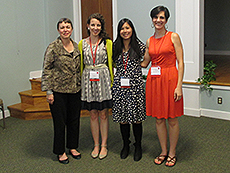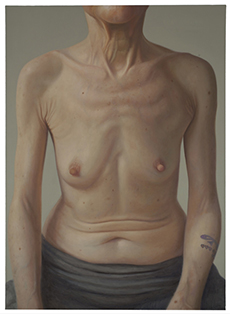Samantha Pious
Masked Manifesto
Every midnight the masked man murdered
one more bureaucrat. He started small—
civil servants, clerks, a social worker, the odd
secretary, a few plodding postmen with God
complexes, even the archivists at City Hall.
Everyone must go! Tax examiners above all.
A mayor, a judge, a traffic cop. He purged
a district of its school board over Christmas break,
then offed the supervisor of a neighboring town.
No one noticed. New paper-pushers, sprouting
like dandelions on a new-mown lawn, spouting
fresh out of college, rushed in to claim their spots,
and smiling students interned every June,
sure their living wage was coming soon.
Desperate, the masked man stepped up his pace.
Poisons, arson, car bombs…he was still only
thinning the herd. The President tweeted,
"Another filibuster—this looks like a job for
@maskedman!" Depressed, defeated,
the masked man considered: an overdose?
a bullet to the head? A failure, he'd be better off dead.
His cell phone rang. (The Batman theme.)
"Hello, Masked Man," came a gravelly voice.
"I'm calling to offer you a choice…
Son, how'dya like to join our team?"
Granny's House
Tell me, Mom, of mansions past,
of fieldstone Fynmere in the woods,
of Heathcote, recently resold
to strangers in the neighborhood,
of renovated Byberry,
and tell me where, or whereabouts
Otsego Hall, our great estate?
And tell me, where is Granny's house?
Tell me of Great-Granny's tea,
the silver tea-set, and the tray,
the Irish maids who brought her lunch,
the maids who took the plates away,
and tell me how the last wave died
on Isidore and Ida Strauss,
and tell me of Eight-Fifty Park,
and tell me, where is Granny's house?
Tell me where the antique books,
the grand piano, out of tune,
the oil portraits, and the busts
redone in bronze, in the living-room,
and tell me where her studio
and watercolors went! I doubt
you recollect her paintbrushes.
And tell me, where is Granny's house?
The sale is closed, the deed is drawn,
we've no more mansions to renounce.
Where's Granny, now her house is gone?
And tell me, where is Granny's house?
|
|
 |
 |
|
|
 |
 |
Jenna Le, Anne-Marie Thompson, and Chelsea Woodard join editor Kim Bridgford at the tenth-anniversary Mezzo Cammin panel at the Poetry by the Sea conference.
Sophia Galifianakis was the recipient of the Mezzo Cammin scholarship.
|
|
|
 |
|
|
|
 |
Corpus VI was formed in 2003, when six women figurative painters, who studied together at the Pennsylvania Academy of the Fine Arts, united to curate, exhibit and present our work to the public on our own terms, and launch our artistic careers. The name was chosen because it reflected our shared commitment to figurative representation. Clarity Haynes, Elena Peteva, and Suzanne Schireson were three of the founding members of the group, which organized an inaugural, self-titled show at Philadelphia's Highwire Gallery in the spring of 2005. The exhibition essay was written by Jeffrey Carr, Dean of the Pennsylvania Academy of the Fine Arts. The exhibition was very well-attended and reviewed in several art publications.
The experience of working together to successfully realize this exhibition, as well as the continuous dialogue and exchange of ideas on contemporary figuration, has proven to be greatly valuable to us. Ten years after graduating from PAFA, as our careers have taken us to different locations across the United States, three of the original members, Clarity Haynes, Suzanne Schireson, and Elena Peteva, have come together to reinvent the collective by inviting one artist each to be part of this exhibition that will begin at the New Bedford Art Museum in fall 2015 and travel to other institutions.
Holly Trostle Brigham, Stacy Latt Savage and Laurie Kaplowitz are professional figurative artists, whose strong artistic visions enrich the collective's range and explorations of contemporary representation. We are excited at the prospect of seeing our work all together in new configurations, creating new dialogues. Holly Brigham creates imaginative, narrative watercolors, which tell a feminist story, inserting her artistic persona into art historical narratives and mythologies. Laurie Kaplowitz uses textured paint to create personages that hint at the soul within, alluding to rituals of marking, scarring and adorning the body as an integral part of our human identity and presentation. Stacy Latt Savage combines figurative elements with fabricated structures and shapes to create objects that capture what it looks like to feel human and the complexities of our human condition. Clarity Haynes casts new light on ideas of beauty, femininity and embodiment through her realistic painted portraits of the female torso. Elena Peteva creates allegorical representations of our individual and social states through the human figure and subtle, charged, incomplete signs that invite the viewer's attempt for interpretation. Suzanne Schireson is influenced by her great-grandfather's autobiography as an early plastic surgeon and her paintings examine contradictions surrounding the birth of cosmetic surgery, such as the power to heal and the fostering of insecurity.
|
|
|
|
|
|
 |
|
 |
|
|
|
|
